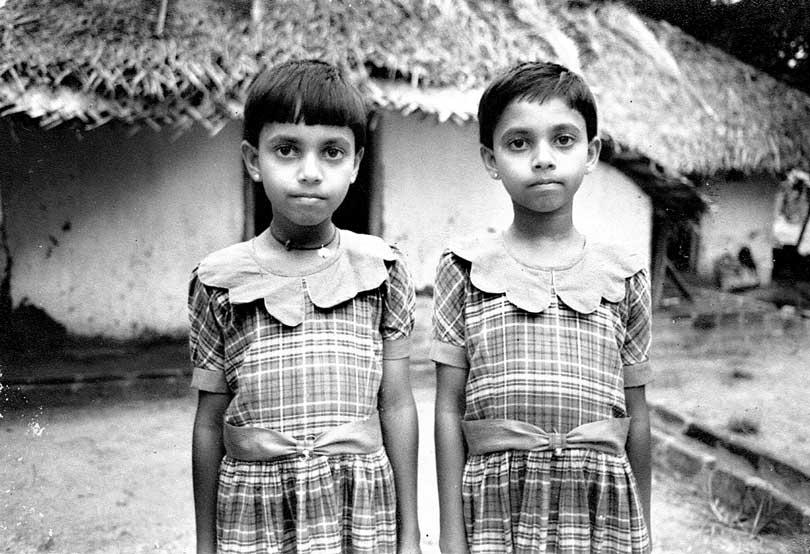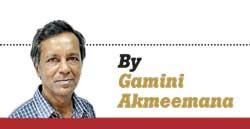21 Sep 2021 - {{hitsCtrl.values.hits}}
 The award winning photograph - Sisters, north Western province
The award winning photograph - Sisters, north Western province
 When I received an email from the French Embassy in Sri Lanka that I have won the French spring festival photography contest titled ‘My island,’ my reaction was one of sheer disbelief. I’m not competition-oriented and this was only the second competition I have taken part in my whole life. I believe in my ability, but photography is a notoriously difficult medium in which to place yourself. Everyone can take pictures nowadays, and almost everyone has taken at least a few good pictures. Critical evaluation can be disappointing, even misleading. In Sri Lanka, it’s almost non-existent.
When I received an email from the French Embassy in Sri Lanka that I have won the French spring festival photography contest titled ‘My island,’ my reaction was one of sheer disbelief. I’m not competition-oriented and this was only the second competition I have taken part in my whole life. I believe in my ability, but photography is a notoriously difficult medium in which to place yourself. Everyone can take pictures nowadays, and almost everyone has taken at least a few good pictures. Critical evaluation can be disappointing, even misleading. In Sri Lanka, it’s almost non-existent.
But I decided to take part in this completion because I had reached a point in my life where I needed to know how others viewed my work. As a photojournalist and photographer, I have earned hardly any money and even less recognition over four decades. My dedication to and love of photography is fierce. That kept me going over the years. But there has been no reward.
To be working in a cultural vacuum, to have done so much work and to be ignored is devastating. Hence, the decision to take part, though the organisers stated that the competition was meant to discover ‘up and coming photographers,’ and I’m now hardly in that category. But I went ahead, anyway.
I selected examples from my work carefully, from film to digital. Entrants could submit any amount. I presumed that many would go for the scenic, highlighting the island’s natural beauty. But I believe that a country’s culture is best expressed through its people, their faces, body language, dress and mannerisms, with architecture, the crafts and the arts in the background. I never imagined winning first place, and thought I might come fourth or fifth considering the range of my work and the sheer hard work I’d put into it.
I believe my approach worked. This is what the embassy’s email said: “Stephen Champion, professional photographer, judged your awarded photography as ‘an image of simplicity and quiet observation; so much a part of the photographic portrait tradition throughout the ages. It is quietly powerful and moving’.”
But the judge’s choice, a stark black and white image titled ‘Sisters,’ of two sisters (maybe twins) I’d snapped while doing a story on agriculture in a village in the Kurunegala district, surprised me. I didn’t consider it to be one of my best pictures. But his assessment, and the interest it evoked in prominent writer and art critic Eric Illyaparachchi, makes me look at it in a different light, and has a profound impact on my whole approach to photography.
Eric Illayaparachchi, when he saw this photo, compared it immediately to the famous painting ‘American Gothic.’ Indeed, when I look at the two images side by side, I’m struck by the similarity of expression. But this very perceptive critic saw much more, and has written an excellent analysis of ‘Sisters,’ taking examples from world photography and cinema. I think his piece is a milestone in Sri Lankan photography criticism. It can be read on www.kinihiriya.com.
As I said earlier, photography is a very difficult medium to evaluate. This is because it is far more commercial than any other serious medium of expression such as writing or painting. In the latter cases, the lines are distinct – commercial writing and commercial art vs. creative writing, literature and painting the kind of art that goes into art galleries and museums. As for photography, the flood of pretty commercial pictures has created a public taste for ‘cover page’ beauty that is both harmful and misleading. Good photography is much, much more.
In photography, too, there is such a distinction. But the line is more blurred because photographers need to be commercial if they want to make a living at it. It’s a very competitive field with millions of commercial photographers. Some make a name for themselves as art photographers, but few manage this feat as the pressures they face are great, and it’s all too easy to give in to money as it starts flowing and believe that you are a great photographer because photography has made you a millionaire.
In my case, I never thought of myself as a great photographer. But I have made a significant contribution to what is essentially a visual expression of culture. Nor was I a ‘gentleman photographer’ who had the means and the leisure to go around with a Leica to take up a high brow hobby. I worked briefly as a photojournalist for the Island newspaper, mainly because that was the best way to learn the craft. I worked all too briefly for Agence France Presse in the 1980s, but had to leave due to pressure from inside the bureau. After that, I was on my own, doing my own documentary photography at my own expense, making a living as a journalist.
Hence, I’m something of an outsider to the photographic community here. I never had a sense of belonging. That’s why the recognition that comes with this award is so important. People can’t ignore me anymore, and it vindicates in some way all the sacrifices I have made in the name of photography.
It has been a long and difficult journey, and I wish to thank so many people. Unfortunately, not all of them can be named here, but I would like to mention Mr. Jude Silva, then manager of Hayleys Photoprint, who offered me Fujifilm at discount rates; Mr. Varuna Kariyakarawana, owner of Varuna Media Centre, who offered equipment at reasonable prices and was more a friend than a businessman, the late Mr. Munidasa who introduced Konica film to Sri Lanka and encouraged and helped so many photographers though hardly anyone remembers him now; Mr. Chandragupta Weerawardene, then photo editor of the Island, Mr. Edmund Gunasekara of Studio Cresenta, Borella who taught me dark room work, Messrs Gabriel Alwis and Punchi Banda of Studio Times who printed the bulk of my pictures, Mr. Lalith Alahakoon, former editor of Midweek Mirror and Daily Mirror, Mr. Nishthar Kassim, then editor of the Daily Mirror financial section, Messrs Jayantha Mayadunne of Kandy, H. D. Perera of Padaviya, Balasundaram of Jaffna, the late Mike Northway and Daphne Northway of Bundala and Jerome Roche of Mannar who helped me in their respective areas, my ex-wife Dharshani who waited patiently as I stopped often by the roadside to take photographs, and the hundreds of people who posed for my camera over the past four decades.
I now hope to find the two sisters whose image brought me so much luck decades later. Though I have forgotten the exact location, I’m determined to find them.
28 Nov 2024 2 hours ago
28 Nov 2024 3 hours ago
28 Nov 2024 4 hours ago
28 Nov 2024 5 hours ago
28 Nov 2024 7 hours ago